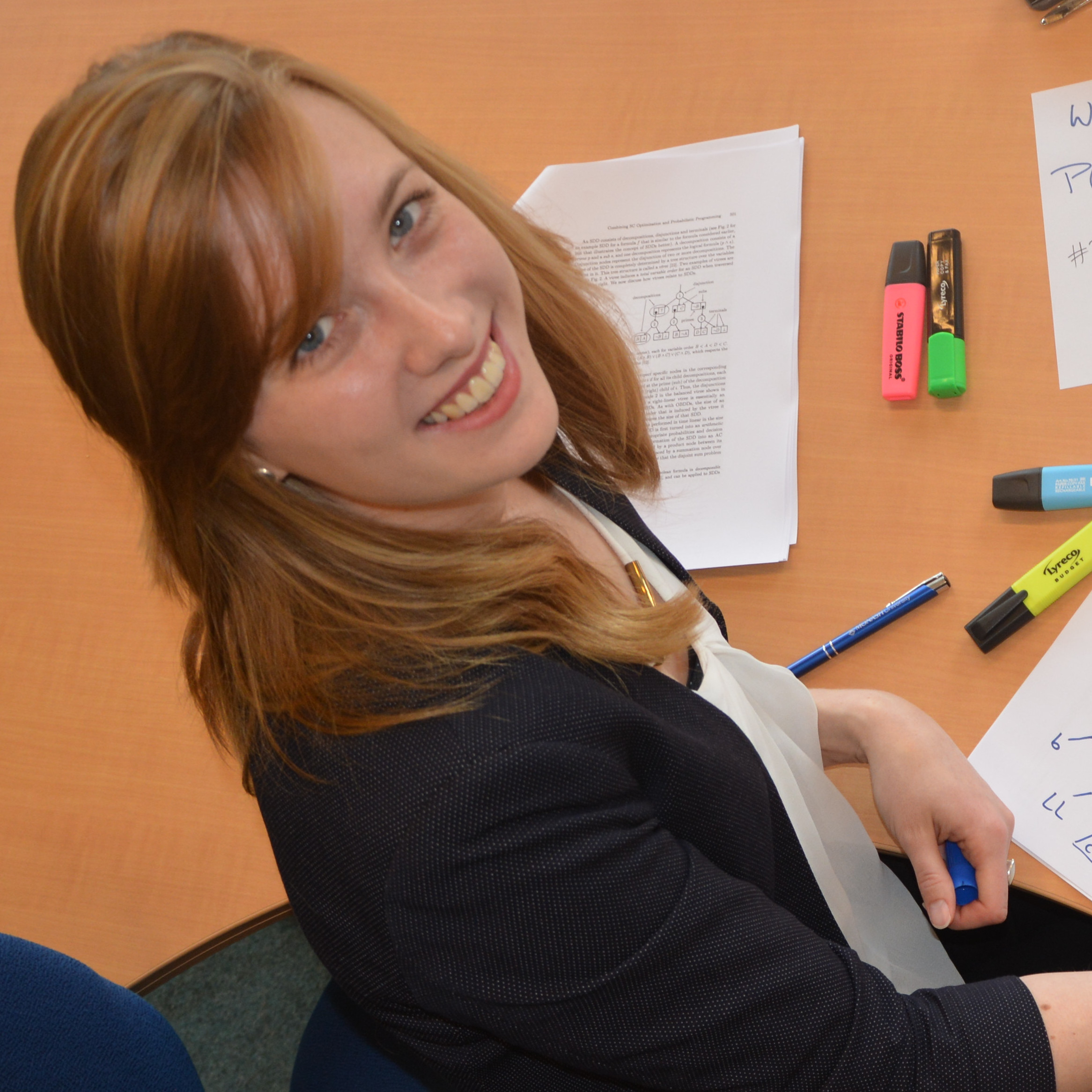IJCAI 2023: Are poster sessions good, actually?
Published:
8 minute read
Last week I attended the 32nd International Joint Conference on Artificial Intelligence (IJCAI 2023) in Macao, SAR.
What stood out most to me this year, is how productive and how much fun the poster sessions were! This was my fourth time presenting a poster, and I honestly never felt like I was particularly good at presenting posters. In designing the poster for our paper, I remembered the ‘Better Research Poster’ video, and tried to apply the principle to my poster, while sticking to my favourite colour scheme.
Presenting my poster
This week, Anna Latour (@aldlatour) presented our work on showing the power of encoding a problem X to another problem that's computationally harder than Y. Yes, you read it right.
— Kuldeep S. Meel (@ksmeel) August 26, 2023
We focused on the classical problem of Identifying code set from sensor placement literature..1/3 pic.twitter.com/MojX6baPBf
After my 8-minute presentation in the CSO: Constraint Programming session (which went well, enough I guess, but there’s not that much you can say in such a short amount of time), I went to the expo hall to where I had put up my poster earlier that day, and waited until someone would come over to have a chat.
The first person to do so, came solely to point out a typo in a table on my poster. Okay. Fair. I guess that means that he at least understood what the table should have shown.
The second person to come up to me, came to make excuses for the first one, and to compliment me on my choice of colour. Okay. Thanks. Could’ve been worse, I guess.
So far, my experience of this poster session wasn’t great, but entirely in line with how I had experienced poster sessions so far. However, things picked up after that! The poster sessions was only 90 minutes, but I ended up spending a good two-and-a-half hours talking to people about our paper, and about their own research.
At some point, there was nobody at my poster, so I took a quick break to find something to drink. When I returned, I found Kuldeep presenting the poster to someone. Firstly: aaaaw, thank you! Secondly: it was so much fun and so educational to hear him explain the project that I had worked on so hard. He has an enormous talent for identifying the key information that the listener needs to know, and to sell the work in a way that the audience immediately grasps its importance!
It seemed that the spicy teaser I had put on the poster as a take-home message did its job. People remembered, and even the next day I had three or four more hours of discussing our work with others. Moreover: people challenged me on it (fair!), which not only allowed me to explain and discuss details, but also taught me a lot about how to think and talk about this research. Loved all the critical questions, even if the side effect was that I wanted to take a one-week vacation to completely rewrite the entire paper.
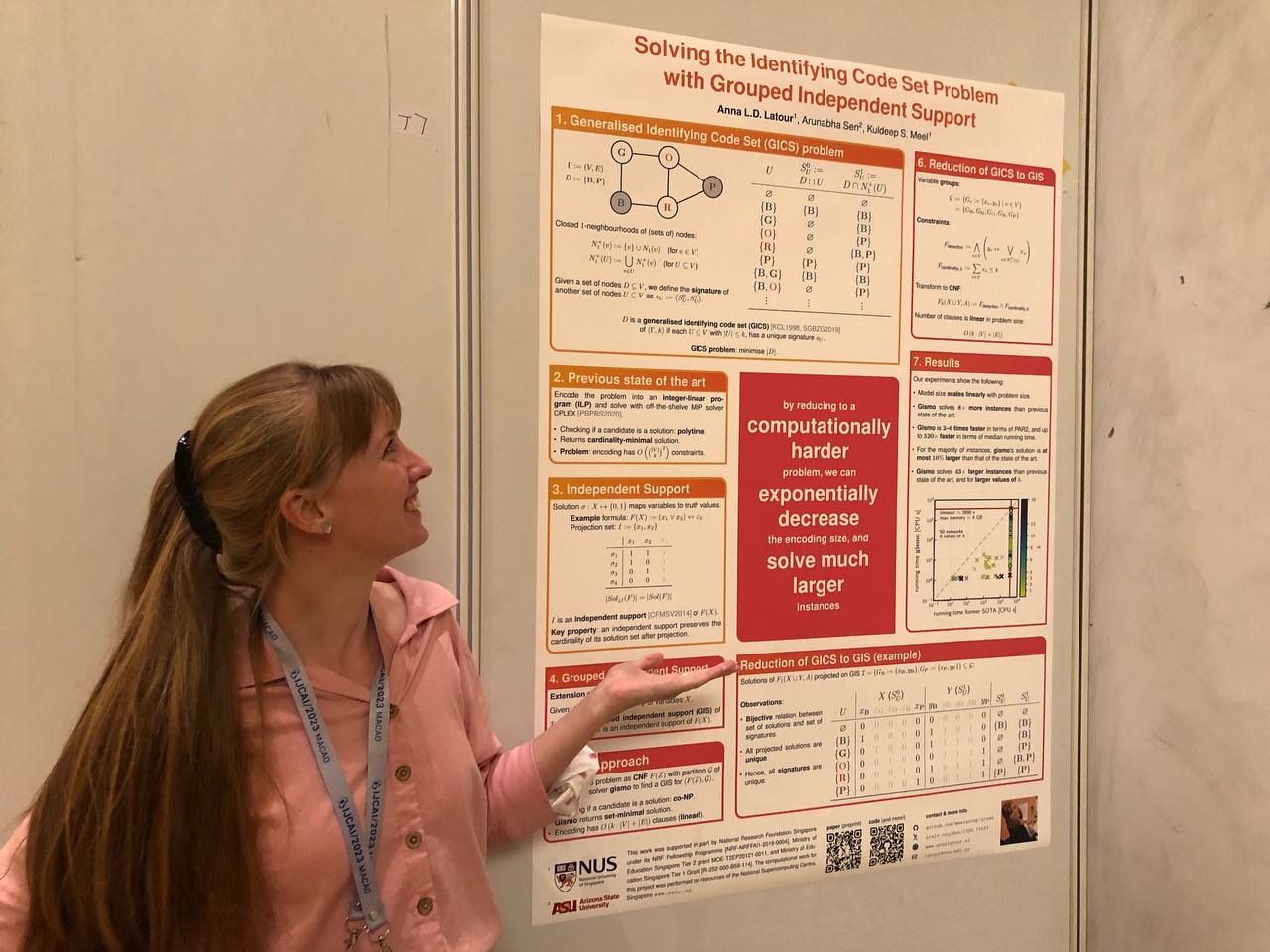
Other people’s posters
I found it incredibly tiring to listen to 8-minute talk after 8-minute talk. I just don’t pick up that much information from these short pitches, and having to keep track of the time and the program, so I can switch from room to room just adds to the cognitive overload that I get at conferences.
Hence, I was very happy to have found the quality of the poster sessions quite high this year, and spent a lot of time in the poster room to check out other people’s posters, and to talk to the researchers who presented them. Here are five of my favourites from this year.
| Ten Cate et al. | Bessiere et al. |
|---|---|
 | 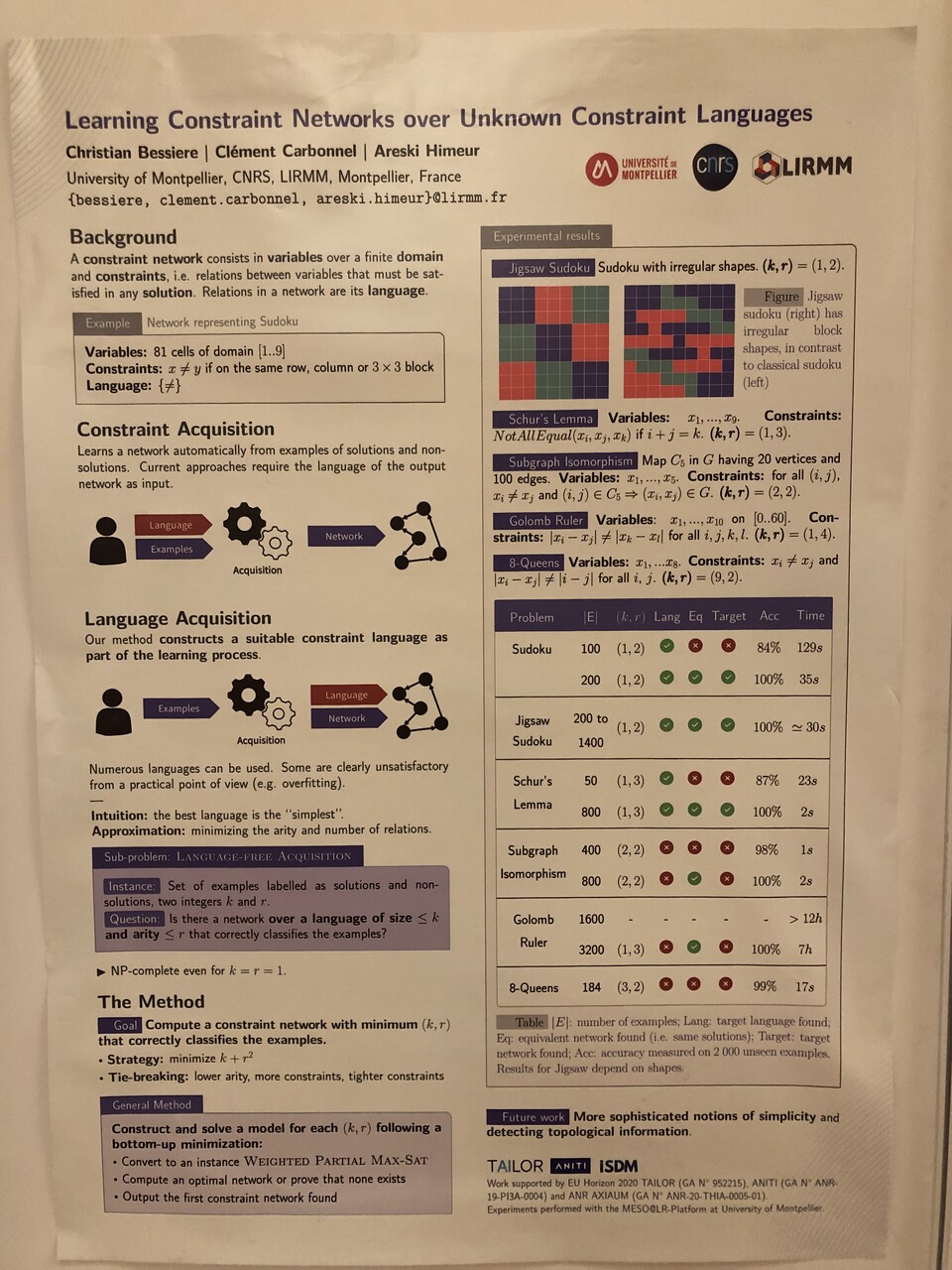 |
My first two favourites are the posters by Ten Cate et al. and by Bessiere et al.
I was very interested to see Ten Cate et al.’s demonstration of an application of SAT solving that I wasn’t familiar with. I wanted to learn more about PAC guarantees, so the fact that they had designed a SAT-based algorithm for learning description logic concepts with PAC guarantees really piqued my interest. I must say that I didn’t have enough background knowledge on both learning and description logic to fully grasp the contents, but I appreciated their efforts to make the poster stand-alone enough that you can get an idea of the contents of the paper by just reading their poster.
I thought the idea behind Bessiere et al.’s work was super interesting. I had never considered learning the constraint language along with the constraints as a goal, but it totally makes sense from the perspective of an end-user who does not necessarily have a CP background. I also very much liked the design of the poster, with clear images and helpful colours and design elements.
| Marinescu et al. | Bofil et al. |
|---|---|
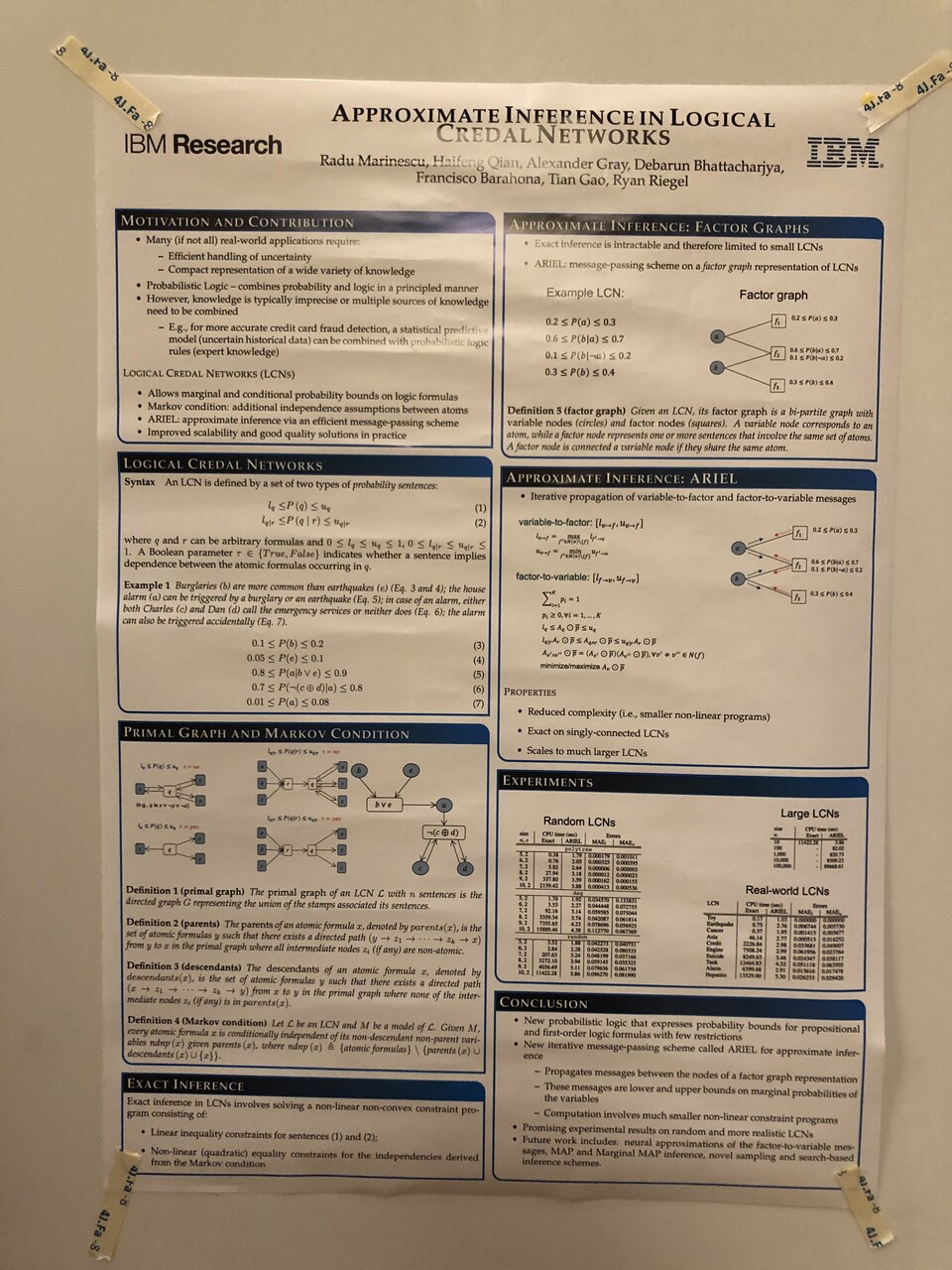 | 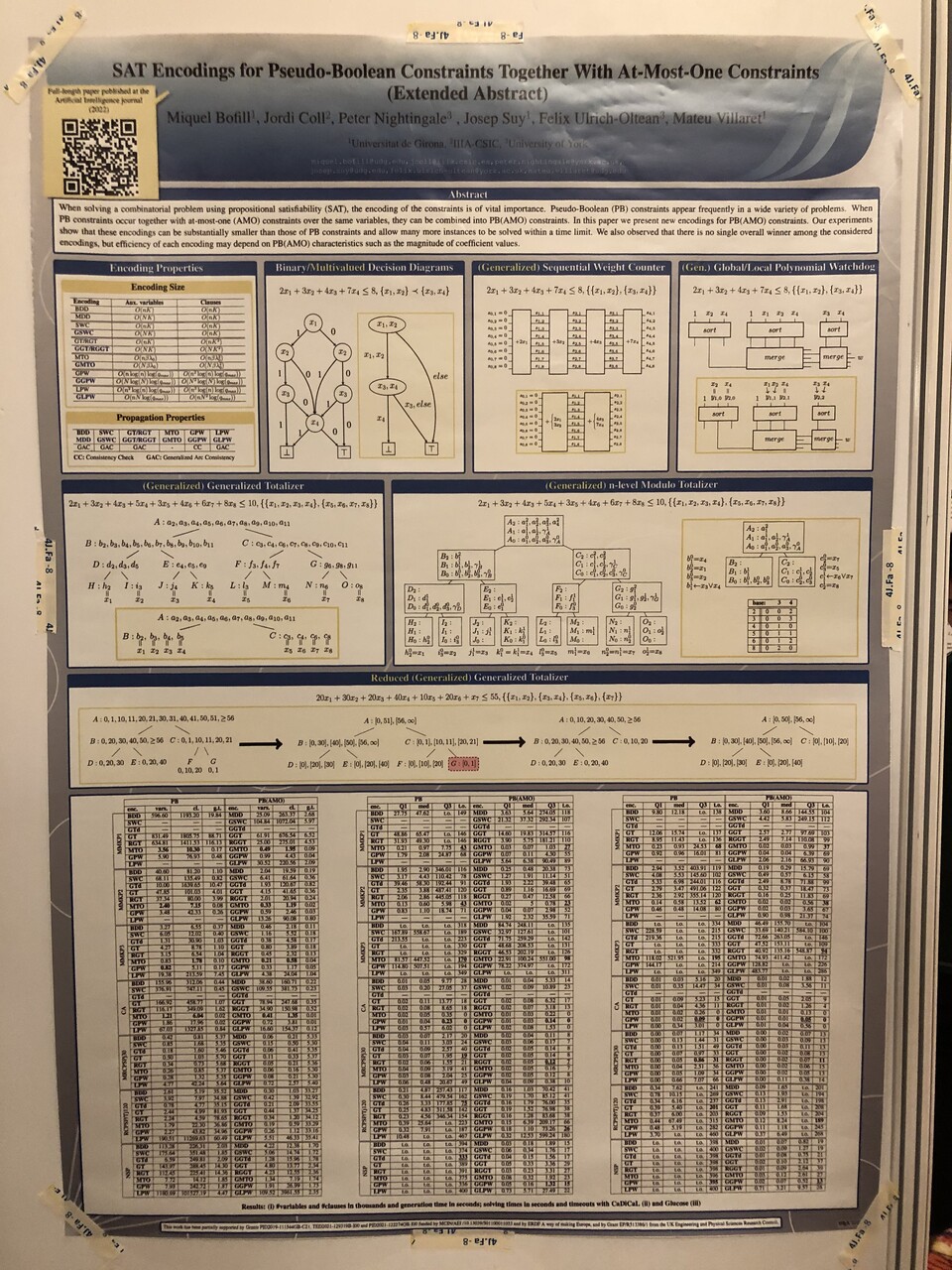 |
The next set of favourites are by Marinescu et al. and Bofil et al.
Obviously, I get excited about pretty much anything that relates to probabilistic inference in networks, so I had to check out this poster. However, even more than learning about the research itself, I enjoyed the chat I had with Radu when he presented his poster. He is incredibly knowledgeable, and I admire him for finding a way to work in industry but still do interesting and relevant academic research, and presenting it at conferences. As a postdoc looking for the next step in her career, I found my chat with him quite inspirational.
I spent quite some time thinking about SAT encodings of different kinds of problems. I did this in the context of understanding (weighted) model counters, in the context of generating test instances, and in the context of debugging solvers. Hence, I was quite intrigued when I saw the poster presenting Bofill et al.’s work. I must admit that I did not care much for the giant table of results that took up half of the poster, but I had a very nice chat with Jordi (who actually remembered meeting me in 2018), and his clear explanation of their results.
And last, but definitely not least, I liked the poster for Toward Job Recommendation for All, by Bied et al.
This poster for sure got people’s attention during the poster sessions, and I think that that’s well-deserved. I find the contribution interesting and relevant; reducing bias in the job market is obviously a task worthy of study. Additionally, the poster has an attractive design that is dominated by figures, a fun movie reference, and a clear take-home message.
However, what I probably like most, is a little easter egg that is hidden in the section headers. An earlier version of my own poster had a reference to the fabulous Daft Punk song Harder, better, faster, stronger. It didn’t quite work for me, though, and I asked the community of academics on Mastodon for help. One of them found the right words to express my discomfort with it, and I ended up removing the reference, even though I felt that it might have been an element of my poster that would attract an audience.
Hence, I was delighted to spot a subtle reference to the song in this poster. One of the authors of the poster/paper actually recognised me from our interaction on Mastodon! What’s even better: he mentioned that during the opening reception, while I was in the uncomfortable situation of having found myself trying to network with some men who were actually trying to test out their PAU skills on me.1 How sweet it was that another person joined that conversation because he recognised me from Mastodon. * chef’s kiss *
They actually told me to my face that the only reason they came over to talk with me was to “learn how to talk to girls”. So there I was. A grown-ass woman. A researcher with an accepted paper at a top conference. An academic looking for the next step in her career. Reduced to a “girl” for boys to practice on. ↩
